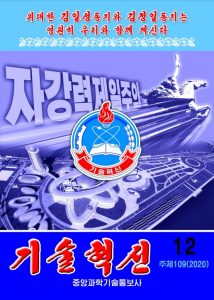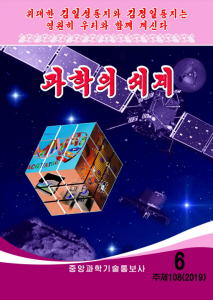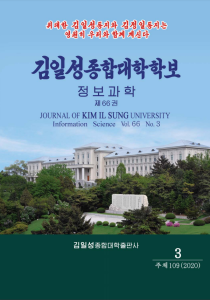North Korea’s Science and Technology Journals: Getting to Know the Scholars (Part 1)

Who are the scientists and engineers of North Korea? What are their backgrounds? Where have they studied abroad? Who are their foreign colleagues? Where are they working now? What do they know? What have they published? What lab equipment do they have? What are their principal areas of research and development?
Such questions are important for analysts, journalists and others trying to piece together such puzzles as the technological level of various industrial sectors in the civilian economy or the state of research and development for weapons of mass destruction (WMD) in the Democratic People’s Republic of Korea (DPRK, or North Korea).[1]
North Korea releases relatively little information on its overall economy, specific industries or such sensitive military topics as WMD programs, but analysts and others can make use of the country’s open sources to gain valuable insights on DPRK science and technology (S&T). The most sensitive information—that regarding WMD and other areas of military research—does not lie between the covers of North Korea’s published books and periodicals. Pyongyang makes available abroad no military science journals or purely military research papers. Yet, a great deal of published information is available that provides a good many pieces to one puzzle or another, whether purely civilian in nature, dual use or military.
This article is the first of two on using DPRK S&T literature and other media as the basis for building relatively detailed profiles of North Korean scientists, engineers and their affiliated institutions. It starts with a list of available S&T periodicals and concludes with a section on its shortcomings in comparison to similar literature published in other countries.
Periodical List and Details
Korea Publications Export & Import Corporation (KPEIC), the DPRK’s exclusive agency for foreign sales of North Korean books and periodicals, publishes a publications catalog that includes Rodong Sinmun, the daily newspaper of the ruling Workers Party of Korea;[2] the illustrated monthly Democratic People’s Republic of Korea and other propaganda journals produced for foreign audiences; and journals in the natural and social sciences.[3]
For this research, 40 DPRK S&T journals were examined (Appendix I includes a full list of titles with bibliographic information).[4]
Many Titles Available, Many More Missing

The 40 periodicals above cover a wide variety of fields, as their titles indicate, including such scientific fields as biology, chemistry, and physics, as well as areas of industrial technology, including agriculture, forestry, and technical innovation in general. Included are several science journals from Kim Il Sung University (KISU), the DPRK’s flagship university. There is also a periodical of international science news, World of Science, for the general reader.
While 40 titles may seem like a relative abundance of riches for a country with a reputation for secrecy, they are only the tip of the iceberg. For example, Kim Chaek University of Technology (KCUT), another of Pyongyang’s powerhouse S&T universities, has its own publishing house. It produces at least one S&T periodical, which is not among the 40 listed in the appendix.[5] One has to wonder how many other DPRK universities, to say nothing of the branches and institutes of the State Academy of Sciences or other work units in North Korea, publish S&T literature.[6]
Short on Information
Compared to comparable periodicals published in other countries, the DPRK publications listed in Appendix I are short on details. Some of the available journals lack article summaries and/or a table of contents in English, a standard feature in journals in China and other countries with S&T literature published in languages other than English.
There is little information on the authors of the articles—only a few of the 40 journals offer any author information at all. Entries in the DPRK’s Journal of Invention include the standard field code (72), which is the name of the inventors, and (77), which appears to identify their affiliated organization. In the journal Agricultural Irrigation and World of Science, some writers are identified as “this company’s reporter” or by title and/or affiliation. It may be reasonable to assume that authors appearing in KISU journals are affiliated with Kim Il Sung University, but their affiliation is not given. No journal in the 40 used for this research includes such standard background information as an author’s education or research interests.

Articles in the journals examined also tend to be much briefer than what is published in scientific journals elsewhere in the world. An article of six pages is comparatively long in journals, where many articles run to only three to four pages. The endnotes, too, are few in number. It is possible to run across an article of one or even two dozen citations, but most have fewer than a half dozen references.[7] By comparison, it is common to have several dozen endnotes in a single article in Western S&T literature.
The accompanying illustrations also seem to be fewer than what would be featured in articles published elsewhere in the world. Pyongyang’s bimonthly World of Science, for example, only features a few illustrations in black and white per issue, whereas Discover and Scientific American, to name two US counterpart periodicals, abound in color photographs and illustrations. North Korean articles also lack language on conflict of interest, common in articles published elsewhere, and an acknowledgments section.
One thing North Korean S&T journals include that is not found in Western journals is political justification. Each article starts with a quote from a leader. Older articles quote the first leader, Kim Il Sung; newer ones tend to cite something from the collected works of Kim Jong Il or something from incumbent Kim Jong Un. The quotations, which can range from the specific to the general, are a justification for researchers to pursue work in one area or another. For example, in an article published last year on calculating equipment efficiency based on the Internet of Things (IoT), the authors started their article with a quote from the current leader on vigorously achieving breakthroughs in advanced technology to build the country’s knowledge economy.[8]
Apart from the above differences, DPRK researchers follow basically the same format as their counterparts in other countries. They set forth a problem, cite previous academic literature, present their materials and methods, offer a conclusion, and end with references.
What’s Next
Having listed the titles available and the shortcomings of those DPRK S&T periodicals, I will offer in the next article ways to use those journals to learn about Pyongyang’s scientists and engineers, from their backgrounds to their international connections, knowledge, and the tools at their disposal.
***
DOWNLOAD PDF
“North Korea’s Science and Technology Journals: Getting to Know the Scholars (Part 1) Appendix I,” by Stephen Mercado
- [1]
For a paper on the collaboration between Pyongyang’s researchers and foreign colleagues and its potential for dual-use and military research and development, see Joshua H. Pollack and Scott LaFoy, “North Korea’s International Scientific Collaborations: Their Scope, Scale, and Potential Dual-Use and Military Significance,” CNS Occasional Paper #43, Middlebury Institute of International Studies at Monterey, December 2018, https://www.nonproliferation.org/wp-content/uploads/2018/12/op43-dprk-international-scientific-collaborations.pdf.
- [2]
This article follows the standard McCune-Reischauer (M-R) system, minus the diacritical marks, for the transliteration of Korean periodical names and Pyongyang’s version of M-R for transliteration of Korean personal names. The two systems are largely the same, but I am using the Pyongyang version for people because author names in Pyongyang S&T periodicals are transliterated that way.
- [3]
For Information on KPEIC and its catalog of DPRK publications for export, see http://www.pyongyangtimes.com.kp/taesongsan/data/list.pdf. Note that the connection is not secure, which is the case for all addresses that start with http rather than https.
- [4]
Accessed via Korean Press Media (KPM), http://www.dprkmedia.com.
- [5]
- [6]
I listed in an earlier article of mine over two dozen titles that, as of 1999, were published by Pyongyang’s Central Information Agency of Science and Technology (CIAST), only several of which are found today in KPM. For that earlier list, see Stephen C. Mercado, “Hermit Surfers of P’yongyang,” Studies in Intelligence 48, no. 1 (2004): 39-44.
- [7]
- [8]
Choe Kyong Il and Han Sok Min, “A Method for Overall Equipment Effectiveness Calculation in Manufacturing,” Journal of Kim Il Sung University: Information Science 67, no. 2 (2021): 60-64.
